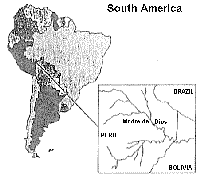 |
Last Update:
Friday November 23, 2018
|
| [Home] |
|
Volume 8 Pages 1 - 47 (February 1993) Citation: Gutleb, A.C., Schenck, C. & Staib, E. (1993) Total Mercury and Methylmercury Levels in Fish from the Department Madre de Díos, Peru. IUCN Otter Spec. Group Bull. 8: 16 - 18 Total Mercury and Methylmercury Levels in Fish from the Department Madre de Díos, Peru Arno C Gutleb1, Christof Schenck and Elka Staib2 1Institute
for Medical Chemistry, University of Veterinary Medicine, Linke
Bahngasse 11, A-1030 Vienna. Austria
Despite growing concern and research interest in the contamination of otters and their food in Europe and North America (Lutra lutra and Lutra canadensis), very little is known about levels of hazardous substances in otters from other areas. In particular it could be of interest whether regions far away from industry and civilisation are contaminated too. The giant otter Pteronura brasiliensis is categorized as almost extinct in two countries of its original distribution, seriously endangered in seven countries, and widespread only in Surinam and Guyana (Foster-Turley et al., 1990). In 1990 a long term investigation and conservation project on Pteronura brasiliensis was started by Frankfurt Zoological Society and Munich Wildlife Society. As part of the Giant Otter Project fish from the southeast of Peru (see Fig. 1) were analysed for their content of mercury and methylmercury. In the area of River Madre do Díos there are still huge parts of untouched tropical rainforest, however, local colonization and gold mining have started. Gold occurs as dust in the sediments of-the rivers and after concentration by washing the mixture of sand and gold is treated with mercury for extraction. With data from the "Banco del Minero" we assume the annual mercury discharge to be in the region of about 9000 kg. As methylmercury biomagnifies upward in the foodchain, top level predators such as otters may accumulate mercury up to toxic levels.
MATERIAL AND METHOD All fish were collected in the Department Madre de Dios. They were caught in rivers and lakes close to the gold-mining activity, but also more than 100 km away in virgin areas, and additionally some were bought on local fishmarkets. Samples were taken from the following fish genera: Potamorhina, Serasalmus, Plagioscion, Prochilodus, Cynodon, Myleus and big catfish like Pseudopimedolus and Pseudoplatystoma. Muscle samples wore stored either in formalin (10 %) or in absolute ethanol prior to analysis. Methylmercury was separated following the method of Bender (1989) using toluene as a solvent for the separation of organic from inorganic mercury. The disintegration is done according to the method of Schnitzer et al. (1987) using a microwave disintegrator (Prolabo Microdigest 300). Mercury levels in the solutions were detected by using Hitachi Z-8100 Polarized Zeeman Atomic Absorption Spectrophotometer with a hydride formation system. For proof of the method, total mercury concentration in a reference standard MA-A-2TM (fish), prepared by the IAEA was determined. RESULTS AND DISCUSSION The findings for the reference standard were between 90 % end 92 % of the given value. No corrections for mercury concentrations in fish were made. Mercury levels in those fish which already have been analysed are below 0.2µg/g wet weight (ppm). This is in the range or slightly higher than the mercury level which is assumed to be tolerable for Lutra lutra (Hovens 1992). Six big fish (up to 50 kg) had a total mercury body burden of 0.46 to 1.55 µg/g wet weight which is lower than the levels for walleye (Stizostedion vitreum) reported from a mercury polluted river in Canada (Fimreite et al. 1973). There are many factors influencing the mercury levels in fish e.g. size of watershed, direct atmospheric deposition, local geology (Wren et at. 1988), low calcium level or pH (Wren et al. 1983). The explanation for the levels of mercury in our study might be owing to a combination of some of these factors. Corresponding to results of Cappon et al. (1981) a similar proportion of methylmercury to mercury (61 to 97 %) in muscle tissues was found. Considering the limited number of samples, mercury and methylmercury levols seem to be low in some species and within the tolerable range. Fish with high mercury levels (Pseudopimelodus and Pseudoplatystoma) are too big (approximately 50 kg) to be a prey for the otter. After having finished the analysis of all samples a full report including a detailed discussion will be published elsewhere. This report will be available from the authors. Nevertheless, direct mercury discharge in areas with viable otter populations should be strictly controlled or preferably banned completely. Particularly as a subtle effect of low mercury concentrations on sublethal mercurialism; i.e. on reproduction and survival of otter populations, cannot be excluded. REFERENCES Bender H.M. (1989). Vorkommen von
Quecksilber im Seehund (Phoca vitulina) und in Eiern von
Flußseeschwalben. Dissertation. Tierärztliche Hochschule Hannover. |
| [Copyright © 2006 - 2050 IUCN/SSC OSG] | [Home] | [Contact Us] |
